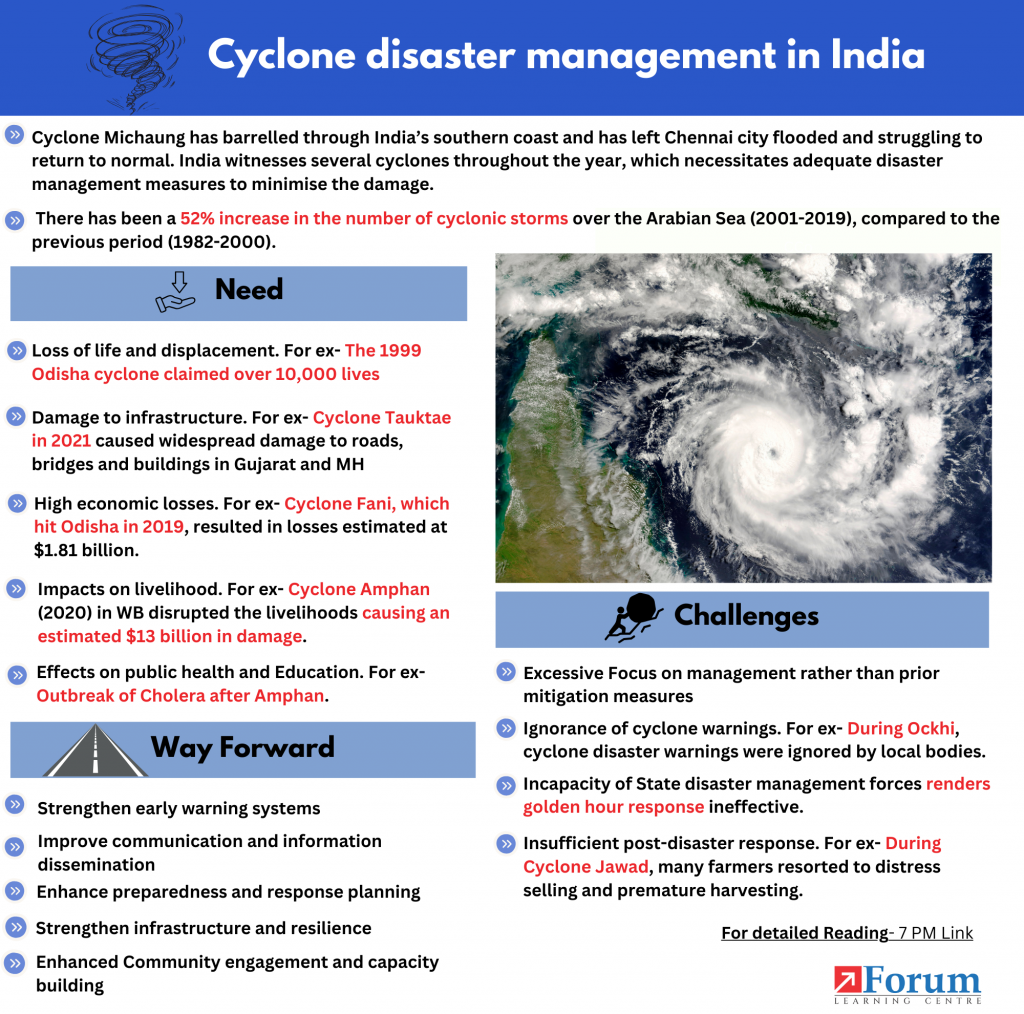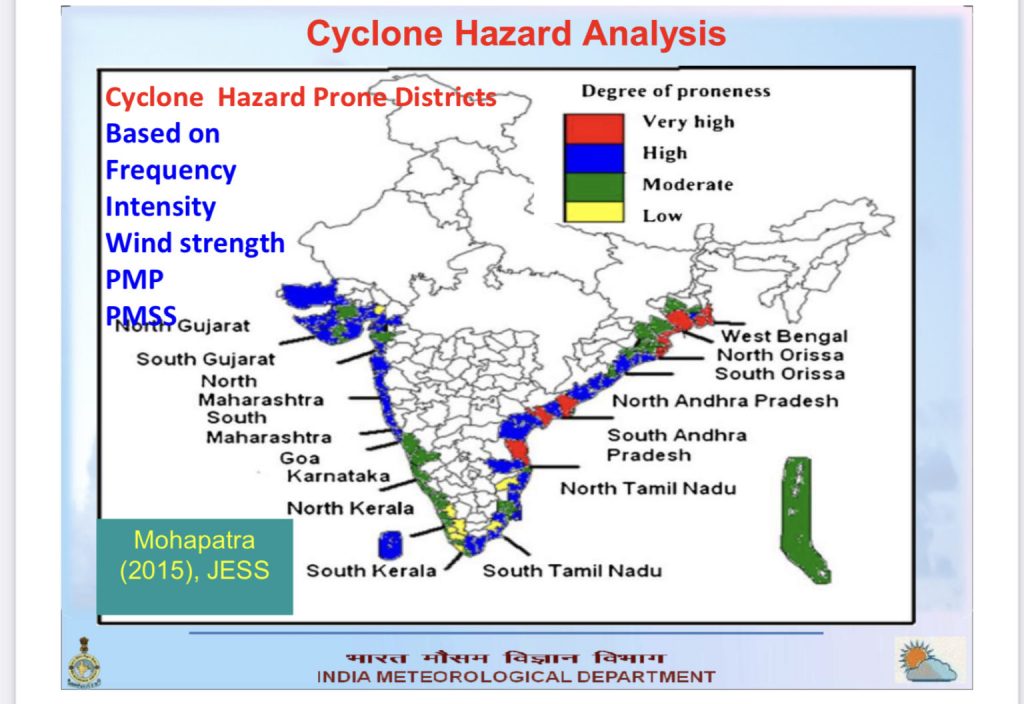ForumIAS announcing GS Foundation Program for UPSC CSE 2025-26 from 19 April. Click Here for more information.
Cyclone Michaung has barrelled through India’s southern coast and has left Chennai city flooded and struggling to return to normal. India witnesses several cyclones throughout the year, which necessitates adequate disaster management measures to minimise the damage. 8% of the geographical area in 13 Coastal States and Union Territories (UTs) of India are affected by severe tropical cyclones year after year.

About Cyclones in India
India’s North Indian Ocean (NIO) region, which encompasses the Bay of Bengal and the Arabian Sea, witnesses high frequency of cyclones. This poses significant threat to the Indian 7,500 km coastline, along with Lakshadweep and the Andaman and Nicobar Islands.
Cyclones from the Bay of Bengal- The Bay of Bengal has experienced an 8% decrease in cyclonic storms in the recent period (2001-2019), compared to the previous period (1982-2000). However, it still dominates in terms of cyclone frequency and intensity compared to the Arabian Sea. These cyclones often originate on the eastern side of the North Indian Ocean (NIO) Basin and initially move in a west-northwesterly direction.
Cyclones from the Arabian Sea- Cyclones in the Arabian Sea are less frequent but no less dangerous. However, there has been a 52% increase in the number of cyclonic storms over the Arabian Sea (2001-2019), compared to the previous period (1982-2000).
What are the cyclone-prone regions of India?

What are the socio-economic impacts of cyclones in India?
Cyclones in India wreak significant havoc, leading to catastrophic socio-economic impacts. These impacts are not only direct, such as property damage and loss of life, but also indirect, affecting long-term economic development and societal well-being.
1. Loss of life and displacement- Historically, cyclones in India have resulted in substantial loss of life. Cyclones also often lead to mass displacement, as people are forced to evacuate their homes due to the imminent danger, leading to social disruption. For ex- the 1999 Odisha cyclone claimed over 10,000 lives. The cyclone also resulted in Mass Displacement of people.
2. Damage to infrastructure- Cyclones cause significant infrastructure damage. This impacts transportation, communication, electricity, and water supply. For Ex- Cyclone Tauktae in 2021 caused widespread damage to roads, bridges and buildings in Gujarat and Maharashtra.
3. High economic losses- The economic impact extends to sectors like agriculture, fisheries, and tourism, affecting the country’s GDP. For Ex- Cyclone Fani, which hit Odisha in 2019, resulted in losses estimated at $1.81 billion.
4. Impacts on livelihoods- Cyclones also negatively impact livelihoods, particularly for fishermen and farmers. For Ex- Cyclone Amphan (2020) in West Bengal disrupted the livelihoods of millions, causing an estimated $13 billion in damage.
5. Effects on public health- Post-cyclone conditions can lead to the spread of waterborne diseases, creating a public health crisis. For Ex- Outbreak of Cholera after Amphan.
6. Impact on education- Cyclones often result in the closure of schools, causing educational disruption. The schools are often used as shelter homes during the cyclones.
7. Long-term economic development- The high cost of post-disaster recovery diverts resources from other areas of economic development. This slows down the overall economic progress of the region.
What are the Cyclone disaster management mitigation and preparedness measures in India?
1. Early warning systems- India Meteorological Department (IMD) early warning system help in the early detection of cyclones. This helps in issuing timely warnings that help evacuate people and limit damage.
2. National Cyclone Risk Mitigation Project (NCRMP)- NCRMP, supported by the World Bank, aims to enhance the preparedness and resilience of coastal communities. This is achieved through the construction of cyclone shelters, infrastructure development, and improved access routes for effective evacuation.
3. Coastal Protection Initiatives- Natural barriers have been created like mangrove plantations and artificial barriers like sea walls and embankments to reduce the impact of cyclones.
4. Infrastructure Retrofitting- Indian government has initiated a retrofitting program to strengthen cyclone shelters in vulnerable areas.
5. Integrated Coastal Zone Management (ICZM) Project- This initiative is designed to enhance the resilience of coastal areas through sustainable environmental practices. The project includes mapping vulnerable zones, promoting conservation, and implementing sustainable livelihood strategies for local communities.
6. Colour-coding of cyclones By IMD- The well-known colour-coding of natural disasters seeks to alert people to the risks’ potential severity in advance. Green, yellow, orange, and red are the colours that IMD uses.
7. Community-based disaster management- These programs are implemented to raise awareness and train communities for cyclone preparedness. For ex- In Odisha, locals have been trained to effectively respond during cyclones.
8. Use of technology- Technology, such as Geographic Information System (GIS) mapping, have been used to help identify vulnerable zones and plan evacuation routes. This technology was notably used during Cyclone Fani in 2019.
9. Coordinated efforts- Effective disaster management requires coordinated efforts among various agencies, such as the National Disaster Management Authority (NDMA), State Disaster Management Authorities (SDMAs), IMD and local administrations.
10. Evacuation planning- Comprehensive evacuation plans are developed for vulnerable regions. For Ex- During Cyclone Amphan in 2020, these plans facilitated the evacuation of over two million people in West Bengal and Bangladesh.
| Read More- El Nino: Concept and impacts |
What are the issues with Cyclone disaster management In India?
India has made considerable progress in managing cyclone disasters, especially in terms of evacuation and early warning systems. However, several challenges persist that need to be addressed for a more effective cyclone disaster management system.
1. Excessive Focus on management- Disaster management in India is more focused on management than prevention.
2. Ignorance of cyclone warnings- One-third of the population of India which lives in the coastal area is poor and marginalized, rendering it ill-prepared and unable to cope with a disaster. On a few occasions, the warnings were not taken seriously by the local communities, thereby making it more disastrous. For ex- During Ockhi cyclone disaster warnings were ignored by local bodies.
3. Incapacity of State disaster management forces- State disaster response forces lack the capacity and preparedness to effectively respond to disasters. As they are ill-prepared to respond, the onus of response always falls on the NDRF rendering golden hour response unavailable.
4. Insufficient post-disaster response- There is a noticeable lack of attention given to post-disaster response in India. For ex- During Cyclone Jawad, many farmers resorted to distress selling and premature harvesting.
5. Inadequate infrastructure- Many buildings, including cyclone shelters, lack the capacity to withstand the impact of a severe cyclone with high storm surges.
6. Communication barriers- Language barriers, illiteracy, and the lack of access to communication tools in rural and marginalized communities hinders the effective dissemination of early warnings and instructions.
What should be done to ensure proper cyclone disaster management in India?
To ensure effective cyclone disaster management in India, several measures and actions can be taken. Here are some key steps that can be implemented:
1. Strengthen early warning systems- Strengthen early warning systems by investing in advanced technologies, such as weather radar systems and satellite imagery, to improve cyclone tracking and prediction.
2. Improve communication and dissemination- Multiple mediums, including mobile networks, radio, television, and social media, should be used to ensure widespread dissemination. For Ex- Odisha Disaster Management.
3. Enhance preparedness and response planning- Regular drills and exercises must be conducted to test the effectiveness of response mechanisms. Coordination among various stakeholders, including government agencies, civil society organizations, and the public must be improved.
4. Strengthen infrastructure and resilience – Investment in the construction and retrofitting of cyclone-resistant infrastructure, including cyclone shelters, coastal embankments, and resilient housing must be increased.
5. Community engagement and capacity building – Regular training programs and workshops to build the capacity of communities, local leaders, and volunteers in disaster management techniques must be conducted.
6. Integration of technology – technological advancements, such as remote sensing, geospatial mapping, and early warning systems must be leveraged, to enhance cyclone monitoring, forecasting, and response.
| Read More- Indian Express UPSC Syllabus- GS 3: Disaster Management: Disaster and disaster management. |




